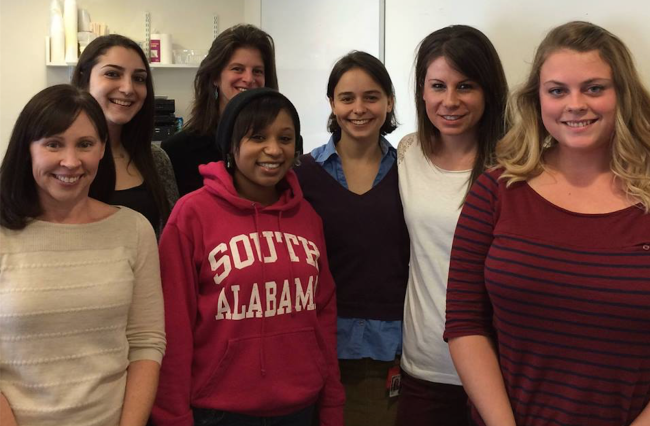You have /5 articles left.
Sign up for a free account or log in.

Amy Farrell, left, with several students from Northeastern's Violence and Justice Research Laboratory
Misha McDonald
Ieke DeVries’s summer is much more social than it was last year, now that she’s working in a lab. But she’s not studying one of the natural sciences, like most lab rats. De Vries is part of Northeastern University’s new Violence and Justice Research Laboratory, housed in the School of Criminology and Criminal Justice.
“The physical space triggers interaction and really helps open up discussions,” especially informal ones, said De Vries, a Ph.D. candidate in criminology. “There are different levels of student and different types of activities being done by a lot of people who have interesting insights to put into the research.”
Northeastern’s Violence and Justice Research Laboratory launched last winter, under the guidance of co-directors Carlos Cuevas, associate professor of psychology, and Amy Farrell, associate professor of criminology. The professors imagined a place where undergraduates to Ph.D. candidates could collaborate and benefit from increased mentoring on social science research.
They worked to secure funding from grants and other sources, found a collaborative space within the college, and designed a loose program as they recruited students to work in the lab -- some 14 total. The lab, currently under renovation, is the research arm of Northeastern's Institute on Race and Justice. As violence research is spread across disciplines including psychology, criminal justice, sociology, public health, medicine and social work, the lab is fundamentally interdisciplinary. Its focus is underserved and understudied populations.
“The lab model really seemed to make sense to us,” Farrell said. “In the past, students learned certain skills sort of ad hoc; they were working on a project where a certain type of methodology was used, so they learned those skills. We wanted to be more systematic, where everyone was getting the same baseline of skills, with mentoring being more structured.”
In some ways, Farrell said, the lab looks similar to other science labs in that there is shared space and regular collaboration. But students aren't "using centrifuges or equipment -- they’re using computers and software packages and talking to each other.”
Like many labs, the Violence and Justice Research Laboratory also has regular meetings. But in addition to talking about ongoing research or administrative issues, Cuevas and Farrell instruct students on certain tools of the trade: a new bit of software, methodology, lab management or writing. As for the latter tool, students have access to a structured writing seminar. Students working on a manuscript get feedback from lab managers before they submit it for publication.
Structured mentoring is also a huge part of the experience. Cuevas said the lab runs on a peer-intergenerational model, in which undergraduates involved in research are mentored by master’s and Ph.D. students, and those graduate students learn how to be mentors. Of course, faculty members mentor everyone.
De Vries, who’s working in the lab on a fellowship, said, “It’s really cool to see how people grow, and to experience yourself as a mentor. Can you really push yourself to explain what you’re doing? It’s really helpful … I’m kind of learning to lead a team on my own.”
Currently, De Vries is involved in several projects related to fighting child trafficking. She’s developing a database tracking minors who have been trafficked or who are vulnerable to being trafficked based on certain characteristics, for example. Other lab work on child trafficking involves that on public opinion and expectations for government intervention, to inform policy decisions.
Misha McDonald, another Ph.D. candidate in criminology and justice policy, is working in the lab as a research assistant for a National Institute of Justice-funded study of bias victimization against Latinos. Goals for project include surveying 900 adult Latinos at three sites across the U.S. about their experiences with victimization. Research is still in the early stages, with a pilot survey planned for the next few months. But McDonald said it’s “especially important given the anti-immigrant rhetoric during and after the last presidential election.”
McDonald said the lab “provides the opportunity to work on a research study from start to finish, which gives us the opportunity for grant management experience.” So far, the pre-data collection work on her project is somewhat solitary. But she anticipates soon getting the “full benefit” of working with a team of students, managing other researchers and perhaps learning from those with more robust statistics knowledge.
One drawback of lab work for McDonald is that her long-term research interests lie in juvenile delinquency and youth violence. There are times she wishes she was spending her research assistant hours on work that more closely related to those goals, she said, but “I didn't want to miss the opportunity to do work that is different from typical academic life. I enjoy the grant management and community outreach work these studies entail.”
Farrell said students still use social media, email and other digital platforms to communicate with one another (and faculty members) about lab work. But “there’s something to that in-the-moment dynamic, that ‘Hey, what are you working on’ dynamic between people, that improves collaboration.”
Cuevas, meanwhile, said the lab maximizes “accessibility” and provides “membership” lacking in many graduate students’ daily lives.
“We can have quick, informal meetings,” he said. “There’s also that sense, ‘This is my place, this is my group of people that I work with.’”
As for why social science labs aren’t more common, Cuevas guessed professors tend to teach and do research the way they were trained to. Funding is also a challenge, he said, since there are fewer sources of external grants in the social sciences than in the natural ones. But he said the lab is a useful format for collaborative, interdisciplinary research, and there was a will for it at Northeastern.
If collaboration isn’t something that's “valued and promoted” on a campus, he said, “it would make it difficult to set up something like we have here.”









